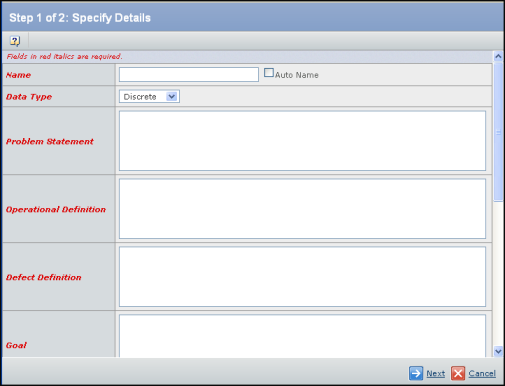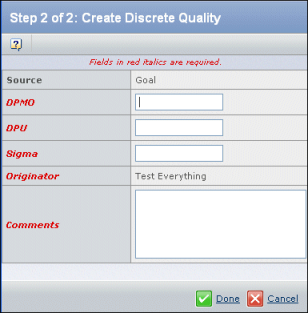Creating a CTQ | |||
| |||
Click Create New from the page Actions menu or toolbar.

Enter details for these fields:
Name. Enter a name for the Quality or to let the system assign a numeric name, check Auto Name.
Data Type. Select Continuous (CTQ is measured) or Discrete (CTQ is counted). The data type determines the metrics gathered for the CTQ.
- Continuous data is information that can be measured on a continuum or scale and can be broken into smaller parts and still have meaning. Money, temperature and time are continuous.
- Discrete data is information that can be categorized into a classification. Discrete data is based on counts. Only a finite number of values is possible, and the values cannot be subdivided meaningfully. For example, the number of parts damaged in shipment.
Problem Statement. An explanation of the problem, when it occurs, where it occurs, and its extent.
Operational Definition. Enter a clear understandable description of what's to be observed and measured, such that different people taking or interpreting the data will do so consistently. This includes what are you trying to measure, what the measurement is not, basic definition of the measure, and how to take the measure in detail.
Defect Definition. Define what counts as a defect.
Goal. Enter goal or target for resolving the defect.
Opportunity. An opportunity is anything that you inspect, measure, or test on a unit that provides a chance of allowing a defect.
Out of Bounds. Enter the measurements that would be outside of the spec limits.
Constraints. Enter any limits or restrictions placed on the measurement.
Comments. Add comments pertaining to the Quality.
Click Next.
The second page of the wizard opens, listing fields that let you define the quality goals to measure against. The data type you selected on the first page determines how goals and metrics are captured and the fields displayed on this page. For discrete, go to step 4. For continuous, go to step 5.
For discrete data, enter values for the following fields. All these fields allow numbers with decimals except DPU, which allows whole numbers only.

Source. For the first metric that defines the values to measure against, the Source is always Goal. For subsequent metrics, you can choose Predicted, Allocated, Measured, Controlled, or Goal. See Quality Metrics and Their Sources for details.
DPMO. Defects Per Million Opportunities. The average number of defects per unit observed during an average production run divided by the number of opportunities to make a defect on the product under study during that run normalized to one million.
DPU. Defects Per Unit is the average number of defects observed when sampling a population.
DPU = Total # of Defects / Total population
Sigma. NORMSINV(1-((Total Defects) / (Total Opportunities))) + 1.5
Comments. Any comments about the CTQ.
For continuous data, enter values for the following fields. All these fields allow numbers with decimals.
Source. For the first metric that defines the values to measure against, the Source is always Goal. For subsequent metrics, you can choose Predicted, Allocated, Measured, Controlled, or Goal. See Quality Metrics and Their Sources for details.
Mean. The desired mean for the end of the project. The mean is the average data point value within a data set. To calculate the mean, add all of the individual data points then divide that figure by the total number of data points.
Standard Deviation. The desired standard deviation for the end of the project. Standard deviation is a statistic used to measure the variation in a distribution. Sample standard deviation is equal to the square root of (the sum of the squared deviations of the mean divided by the sample size minus 1).
Upper Spec Limit. The desired upper specification limit for the end of the project, as specified by the customer.
Lower Spec Limit. The desired lower specification limit for the end of the project, as specified by the customer.
Sigma. NORMSINV(1-((Total Defects) / (Total Opportunities))) + 1.5
Click Done.